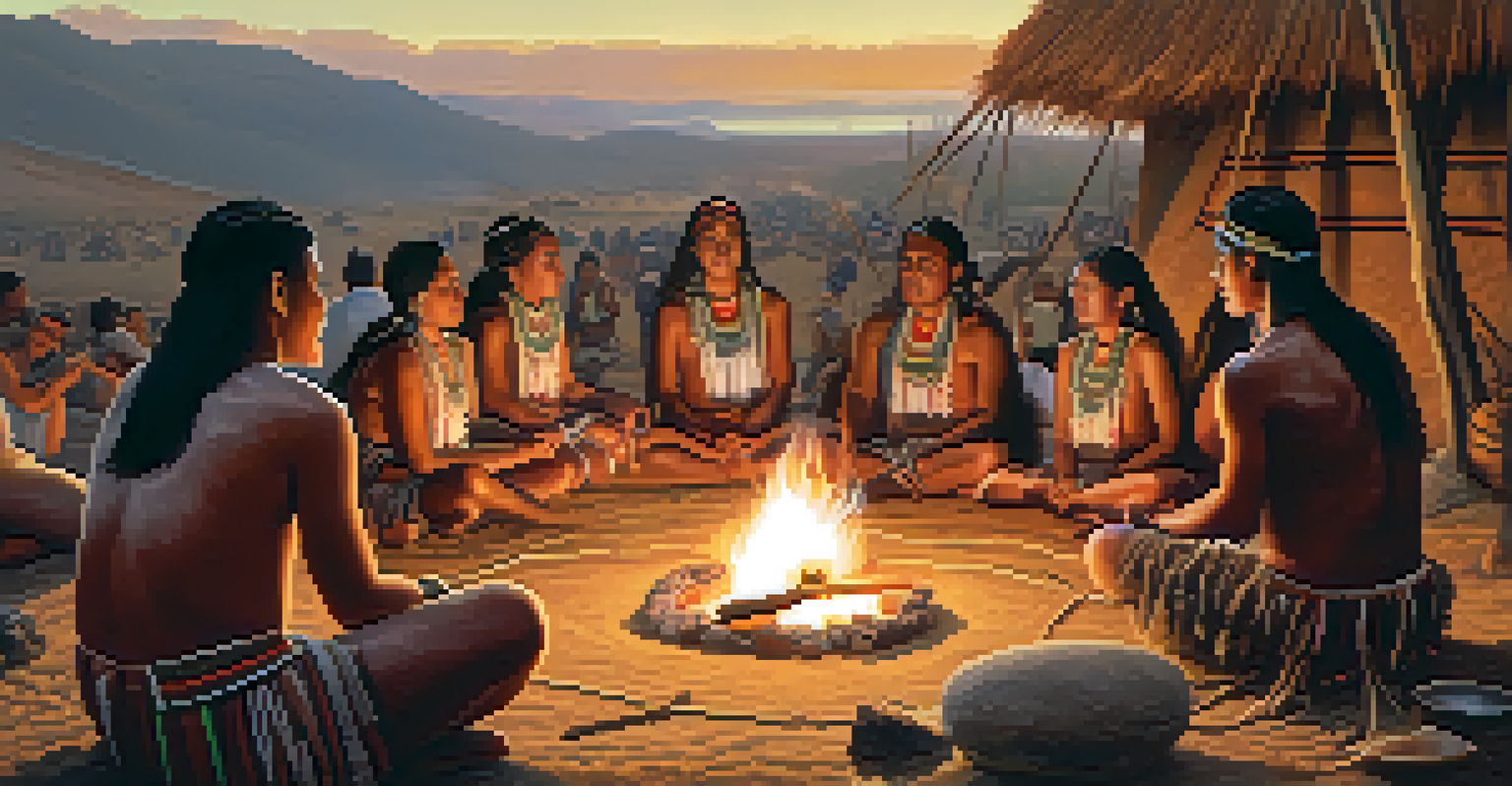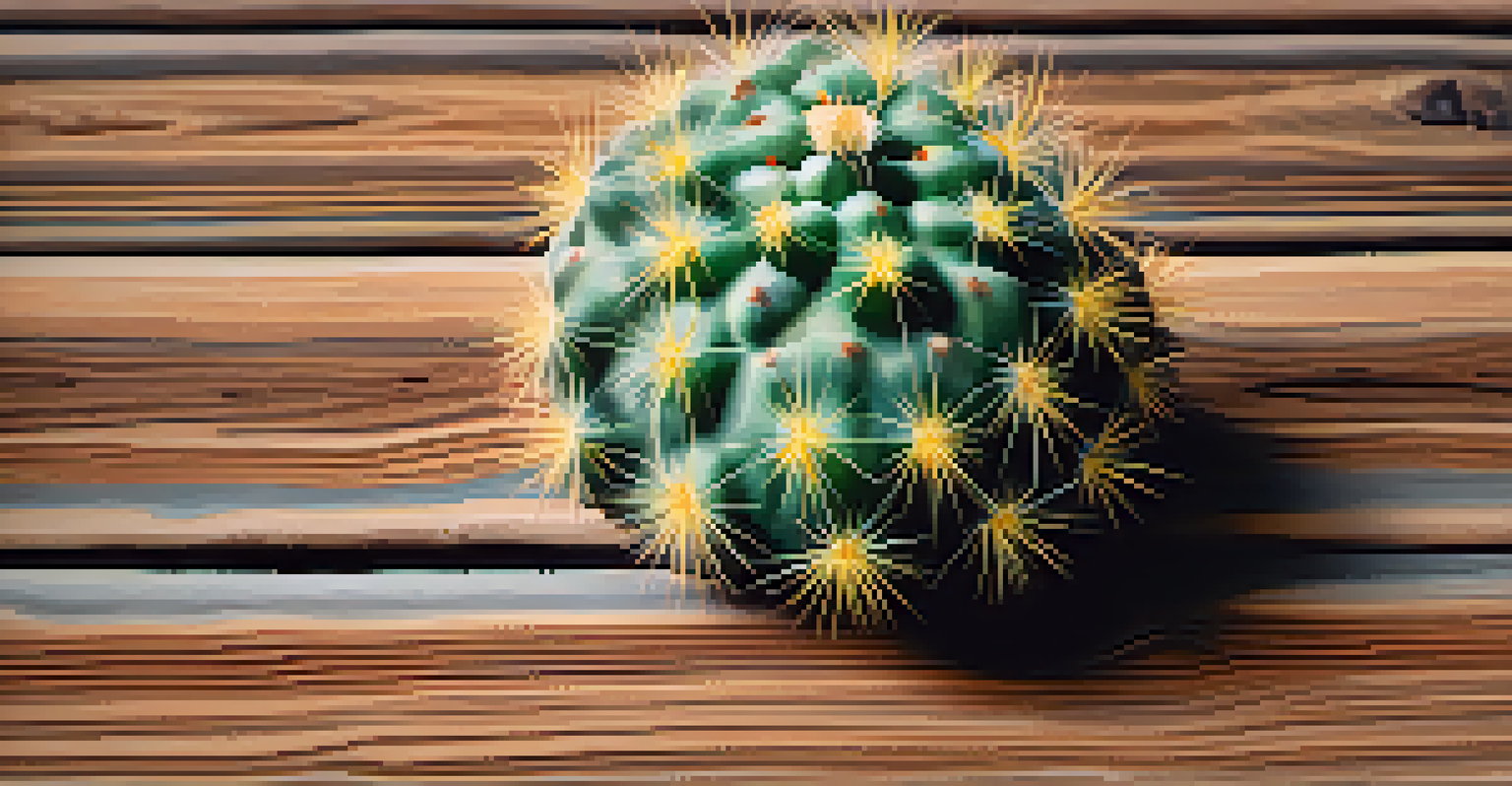Peyote Rituals: Weaving Stories Through Cultural Practices

Understanding Peyote: A Sacred Plant with Deep Roots
Peyote, a small cactus native to Mexico, holds profound significance in various Indigenous cultures. This plant is not just a natural wonder but also a vital element in spiritual ceremonies, often associated with healing and vision quests. Its psychoactive properties have been revered for centuries, making it a central figure in rituals aimed at connecting with the divine.
The plant is a sacred gift, a pathway to the divine, and a tool for healing that has been honored for generations.
Historically, Peyote has been used by Native American tribes, including the Huichol and the Navajo, each incorporating it into their unique spiritual practices. The act of consuming Peyote is more than just a physical experience; it is a deeply spiritual journey that fosters a sense of community and shared understanding among participants. It brings people together, weaving their stories into a collective narrative.
In many cultures, the use of Peyote is intertwined with the understanding of nature and the cosmos. This sacred plant invites individuals to reflect on their personal and communal experiences, creating a tapestry of stories that highlight both struggles and triumphs. Each Peyote ceremony is a testament to the resilience and richness of these cultural narratives.
The Role of Rituals in Peyote Ceremonies
Rituals serve as the backbone of Peyote ceremonies, providing structure and meaning to the experience. These rituals often involve songs, prayers, and communal sharing, allowing participants to connect with each other and the spiritual realm. Each element is carefully crafted to enhance the ceremony's purpose, which is often centered around healing and guidance.

During these gatherings, participants may recount personal stories or share wisdom passed down through generations. This storytelling aspect is crucial, as it reinforces cultural identity and collective memory. The act of sharing stories not only honors ancestors but also solidifies bonds among those present, creating a sense of belonging.
Peyote's Cultural Importance
Peyote serves as a symbol of cultural identity, preserving traditions and reinforcing Indigenous heritage through spiritual rituals.
Moreover, the rituals surrounding Peyote consumption often include drumming and singing, which help to create a sacred atmosphere. This rhythmic soundscape aids in guiding participants through their individual and shared journeys, allowing them to navigate the spiritual landscape more effectively. The blend of music, storytelling, and shared intention transforms the ceremony into a profound experience.
Healing Through Peyote: A Personal and Collective Journey
Many who participate in Peyote rituals report experiences of deep healing, both physical and emotional. The process often involves confronting personal challenges, leading to insights that can shift perspectives and foster growth. This healing journey is not just an individual pursuit; it reinforces the importance of community support.
Rituals are the heartbeat of our culture, reminding us of who we are and where we come from.
In these ceremonies, participants often find comfort in the shared experiences of others, recognizing that they are not alone in their struggles. This collective healing fosters an environment where vulnerabilities can be expressed and understood, strengthening communal ties. The stories shared during these moments can serve as powerful catalysts for transformation.
Furthermore, the act of engaging with Peyote in a ceremonial context emphasizes the importance of respect for nature. Participants learn to honor the plant and its gifts, understanding that their healing is deeply connected to the health of their environment. This holistic approach to healing promotes a sustainable relationship with nature and each other.
Cultural Significance: Peyote and Indigenous Identity
Peyote is more than just a plant; it is a symbol of cultural identity for many Indigenous peoples. Its use in rituals allows for the preservation of traditions and the transmission of cultural knowledge across generations. These practices highlight the importance of maintaining a connection to one’s roots, even in the face of modern challenges.
For many tribes, the Peyote ceremony is a space where cultural values are reaffirmed and celebrated. It acts as a reminder of the wisdom embedded in their customs and stories, reinforcing a sense of pride in their heritage. This connection to identity is crucial in a world that often seeks to erase such narratives.
Healing Through Community
Peyote ceremonies foster deep healing by creating a supportive environment where participants share personal stories and experiences.
Additionally, the ongoing struggles for Indigenous rights and recognition underscore the importance of Peyote rituals. Engaging with these ceremonies provides a platform for cultural expression and resilience, asserting the significance of their traditions in contemporary society. It is a powerful declaration of existence and continuity.
Peyote and the Legal Landscape: A Complex Journey
The legal status of Peyote is a complex issue, often intersecting with cultural rights and religious freedoms. In the United States, Indigenous groups have fought for the right to use Peyote in their spiritual practices, leading to legal protections for these ceremonies. However, the ongoing challenges highlight the tension between cultural preservation and legal restrictions.
In many places, the use of Peyote remains illegal for non-Indigenous individuals, which raises questions about access and respect for cultural practices. This legal divide creates a barrier that can hinder the sharing of these rich traditions outside their communities. It emphasizes the need for ongoing dialogue and understanding regarding Indigenous rights.
Moreover, as interest in Peyote grows among non-Indigenous populations, it is essential to approach the topic with sensitivity. Understanding the cultural significance of these rituals can foster respect and appreciation rather than appropriation. Advocating for the rights of Indigenous peoples is crucial in ensuring that their stories and practices continue to thrive.
Modern Adaptations: Peyote in Contemporary Practices
As societies evolve, so too do the practices surrounding Peyote. Many Indigenous communities are finding innovative ways to incorporate modern elements into traditional rituals while still honoring their roots. This blending of old and new allows for the continuation of cultural practices in a way that resonates with younger generations.
For instance, some groups are using technology to share their Peyote experiences and educate others about its significance. Social media platforms have become spaces for storytelling and cultural exchange, creating a broader understanding of these rituals. This modern approach does not replace the traditional but rather complements it, keeping the spirit of the rituals alive.
Legal Challenges for Peyote Use
The legal status of Peyote intersects with cultural rights, highlighting the ongoing struggle for Indigenous groups to practice their traditions freely.
Additionally, contemporary adaptations may also involve collaborations with artists and scholars, fostering a richer dialogue about the cultural importance of Peyote. These partnerships can help to bridge gaps between communities, fostering understanding and respect for Indigenous practices. In this way, Peyote rituals continue to evolve while remaining deeply rooted in their historical context.
Conclusion: Weaving Stories Through Peyote Rituals
Peyote rituals serve as a powerful reminder of the interconnectedness of culture, identity, and spirituality. They are spaces where stories are shared, healing occurs, and traditions are upheld. Through these ceremonies, participants can find a sense of belonging and purpose, weaving their narratives into the larger tapestry of their communities.
By understanding and respecting the significance of Peyote rituals, we can appreciate the rich cultural heritage they embody. This appreciation fosters a deeper connection to the stories and experiences of Indigenous peoples, promoting empathy and understanding. As we move forward, it is vital to support the rights of these communities to practice their traditions freely.

Ultimately, Peyote rituals remind us of the power of storytelling in shaping our identities and communities. They invite us to reflect on our own narratives while honoring those of others, creating a collective understanding that transcends generations. In this way, Peyote becomes not just a plant but a bridge connecting our past, present, and future.